How to Be a Responsible Tourist: 22 Effective Tips to “Blend In”
If you’re reading this, you’re probably wondering how to be a responsible tourist? Responsible tourism is a term that is becoming more widely used in an effort to counteract the negative effects tourism has created in recent years. But what are the traits of a responsible tourist? What exactly does being a responsible tourist entail?
My like-minded friend, you’re about to find out all the answers to these burning questions. To put it in the most simple of terms, the best way to be a responsible tourist is to be an invisible tourist. Considering the name of this blog, you may be beginning to sense a theme.
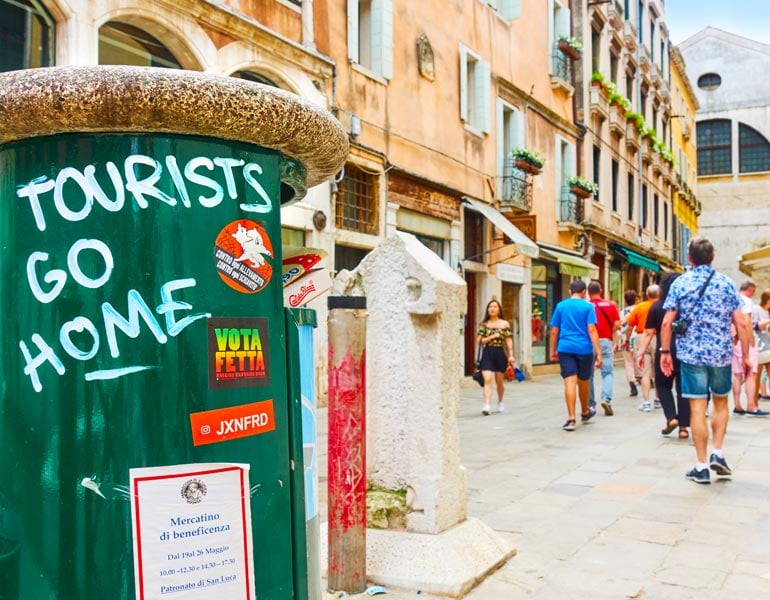
During my travels across four continents since 2008, I‘ve witnessed more than my fair share of tourists behaving badly — whether intentionally or otherwise. In this time I’ve experienced the ways travel has changed and how attitudes have shifted. I’ve also rolled my eyes too many times to count! Above all, however, my passion has only grown to spread awareness about the importance of responsible tourism.
To turn lemons into lemonade, I have my encounters with irresponsible tourists to thank for being one of the reasons why I created this responsible travel blog back in 2017. Responsible tourist behaviour begins with the willingness to learn, so you’ve already made the first step. And, I’m so glad to have you here!
So, how’s your invisibility cloak? If you want to learn the ways to be a responsible tourist moving forward, grab yourself a cuppa and get comfy — this is a lengthy one!
This post contains affiliate links, at no extra cost to you. I may earn a small commission if you click through and make a purchase.
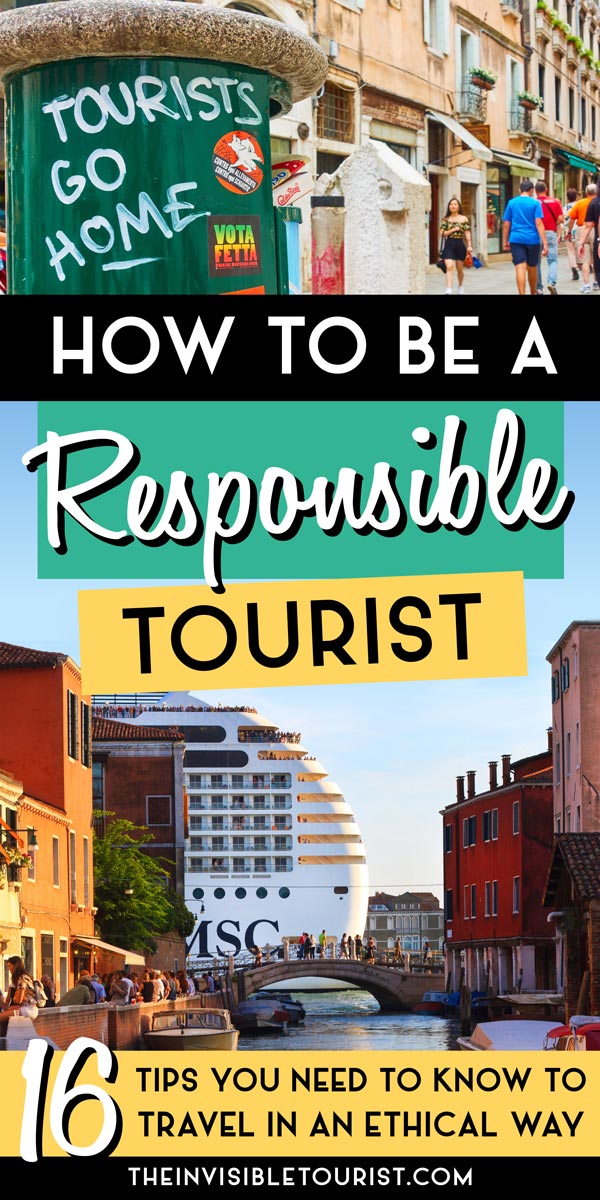
What is responsible tourism?
Responsible Tourism relies on the individual and their choices to create a positive, lasting impact on the destination. According to the Cape Town Declaration of 2002, Responsible Tourism can be defined as making “better places for people to live in and better places for people to visit” — a win-win for everyone.
Behind the scenes from day one, I’ve seamlessly interwoven everything I’m about to detail below into my popular travel guides and itineraries to help you better “blend in” when travelling. Not only will this help to enrich your future trips, it also benefits the local community of the destination.
There are over 150 types of tourism – with one in ten jobs relying on the industry to account for 10% of global GDP.
It’s important to note Responsible and Sustainable Tourism are not the same thing. These terms are often confused and used interchangeably. While the purpose of each is to alleviate negative social, economic and environmental impacts caused by tourism, they aim to achieve these through different ways.
Sustainable Tourism forms part of Responsible Tourism — here, I’ll explain.
Sustainable and Responsible Tourism
Sustainable Tourism takes current and future issues into account regarding economic, environmental and social impacts. It usually involves political input and stakeholder participation to agree on reform with planning and management.
This includes implementing measures to ensure fair redistribution of profits, social services for local communities and creating stable employment opportunities to help alleviate poverty.
TIP: An easy way to remember the difference is: When it comes to tourism, the responsible choice is to take a sustainable approach.
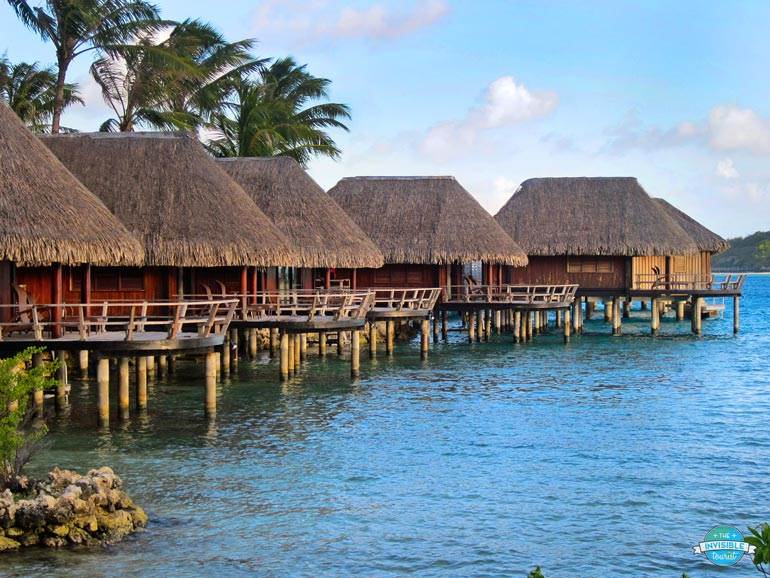
How to be a responsible tourist? Examples of responsible tourist behaviour
Times have changed. Things that were previously acceptable years ago are no longer. And that’s not always a bad thing! To lessen the negative impacts of tourism on ourselves, locals and the environment, we need to shift our focus to travelling in a more responsible way.
While I have written a detailed guide about what you can do to specifically avoid contributing to overtourism, the following actions cover a broader range of steps to follow to be a more responsible tourist overall.
Let’s call these responsible tourist behaviours examples the “new” rules of tourism, shall we?
Responsible tourism examples includes giving back
Being a responsible tourist involves giving back to locals, not just about what you can take. After all, the aim is to leave a lasting positive impression on the destination – not turn it into a shell of its former self due to being ravaged by selfish tourists.
The following options ensure your tourism money stays within the local economy and benefits communities that rely on it:
Enjoy cultural experiences
There is no better way to understand and appreciate the local population than by undertaking cultural activities through local operators. Isn’t experiencing different cultures one of the reasons why we travel?
As a tourist, you’re helping to preserve the cultural heritage of a destination by keeping old traditions alive, such as taking a traditional tea ceremony in Japan or a chocolate making class in Belgium.
The huge advantage to you is cultural experiences open your mind to new ways of thinking and provide you with insider knowledge you may not have been able to obtain on your own. I never fail to come away feeling inspired and appreciative of the significance of things afterwards!
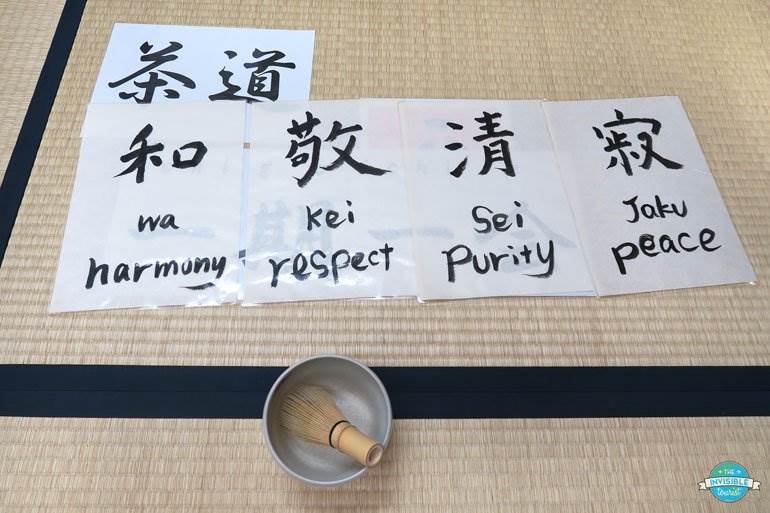
Support local small businesses
Supporting small local businesses is a big part of being a responsible tourist. These family-run businesses are the unseen cogs turning the wheels of the local economy. When you spend your money at a small business, you’re supporting local jobs within the community, allowing families to put food on the table and helping pay their bills. Each encounter is also unique as the personality of the store owners shine through.
In contrast, the money spent at large international chains such as McDonald’s or Starbucks doesn’t stay long in the local economy before it gets passed higher up the chain (and offshore). The experience in these chains can be cookie-cutter and impersonal, too, whereas a customer to a small business carries a higher value.
Whether it’s dining in local restaurants, cafes or ordering street food, purchasing from a small business usually also means you’ll have a more authentic foodie experience than from an internationally recognised franchise.
When shopping for clothing, I also kindly urge you to rethink and avoid fast fashion retailers such as H&M, Primark and Zara. The low-quality, high-turnover apparel sold in these kinds of stores is not only unsustainable, it’s a major contributor to global waterway pollution and has been found to exploit workers from developing countries.
Consider purchasing unique, handmade clothing pieces and souvenirs by local makers to support their craft. You won’t see them on anyone else!
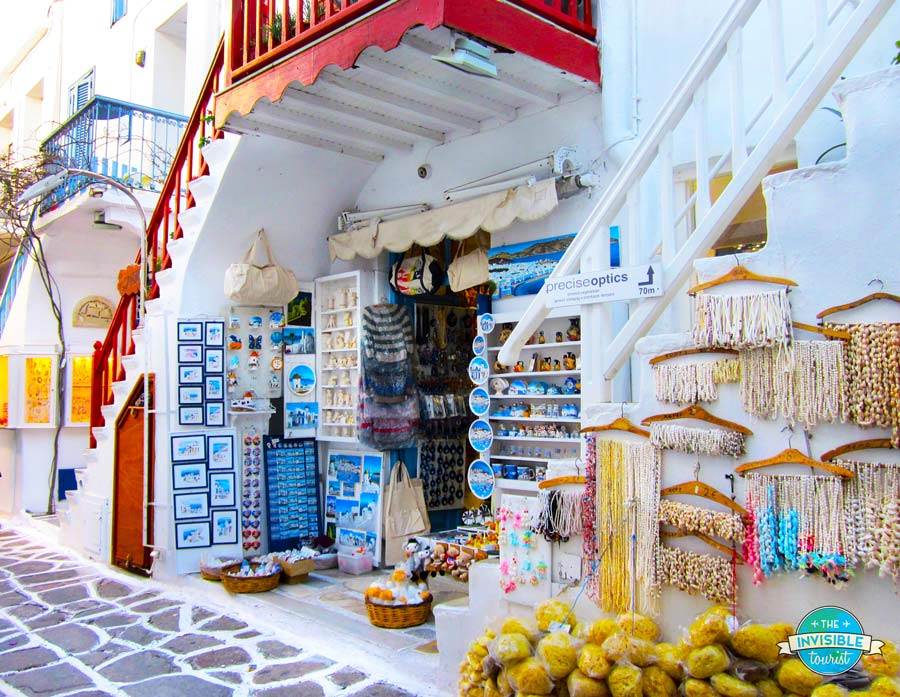
Rethink accommodation options
If possible, select accommodation owned and run by locals rather than the huge international chains to help money stay within the community. While some travellers like to cash in on points through loyalty programs run by large chains, something I’ve observed over the years is that they aren’t always situated in convenient locations at a destination.
Staying in a location that isn’t central can involve a lot of back and forth from the main sights to your accommodation – time that could be better spent doing something more meaningful.
In places like Japan, staying in a family-run inn (ryokan) is an absolute must to fully experience exceptional Japanese hospitality. The service is unparalleled and it is an amazing culturally-immersive treat.
Be respectful of local cultures, customs and etiquette
Nothing screams “tourist” more than not knowing the correct way to behave or act, whether it’s intentional or not. In order to not stir trouble and create resentment against tourists from locals, it’s essential to know the do’s and don’ts at your destination. What may be acceptable at home very well may not be abroad!
Do you know why it’s inappropriate to show the sole of your foot in some parts of Asia and the Middle East? Why it’s essential to slurp your noodles in Japan? Or why it’s crucial not to smile at strangers in Russia? It’s important to know how to be a respectful tourist.
My entire “Be Invisible” series examines local customs, etiquette and mistakes to avoid when abroad. I’ve reached out to locals across the globe to share their insights into how you can best blend in and be an invisible tourist when visiting their homeland.
If you’re hoping to be a more ethical and responsible tourist, the series has you covered from Asia to Europe, Oceania to North America. Why not take a look to find out the cultural norms and taboos at your next destination?
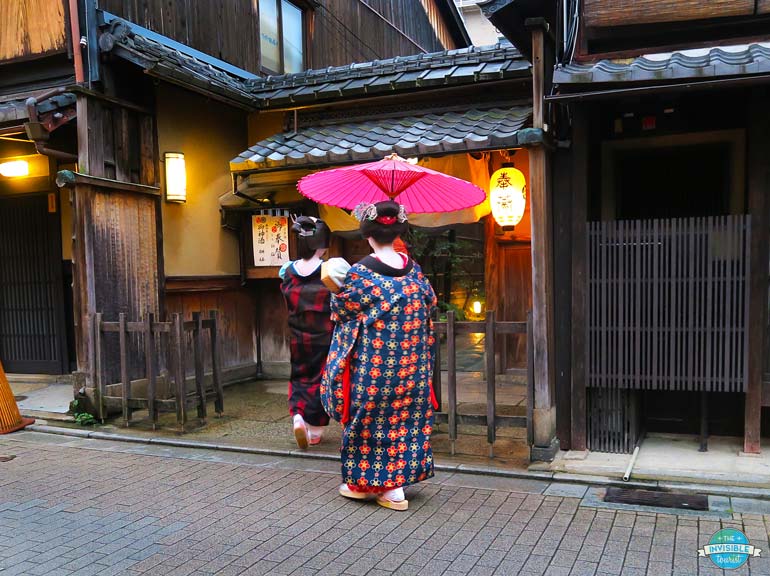
Responsible travel tips include reduce, reuse, recycle
While these could be considered traits of a sustainable tourist, as we discussed earlier sustainability falls under responsible tourist behaviour. As individuals these choices may seem like a drop in the ocean overall, however small actions multiplied over hundreds (if not thousands) of people can quickly add up!
Here are a few ways you can reduce, reuse and recycle when travelling to minimise negative impacts on the environment and infrastructure of a destination:
- Reduce your shower time at your accommodation to help preserve local water supplies
- Reuse your hotel linens such as towels and sheets during your stay. This helps reduce the amount of unnecessary industrial washing
- Reduce electricity use by turning off lights and air conditioning in your accommodation whilst you’re not there
- Reduce or eliminate using private transport for short journeys that could be walked where possible (or hire a local bicycle!)
- Bring a reusable water bottle to refill during your trip rather than purchase multiple plastic bottles of water
- Reduce single-use toiletries by bringing your own from home
- Bring your own reusable shopping bag when you’re out and about to minimise taking on new plastic bags
- Hang on to your rubbish and correctly dispose of it according to local recommendations on recycling
- When in Asia, bring your own reusable chopsticks. It’s believed that 24 billion pairs of disposable chopsticks are used annually in Japan alone!
- Have any more ideas to share? Let me know in the comments at this article’s conclusion.

Travel off peak seasonally and daily
This is a great way to be a more responsible tourist, perhaps you’ve even done it before without realising. When we talk about travelling off-peak, this refers to visiting a destination in its off-season or shoulder season (the periods of time when it’s not popular to visit, such as winter or when the weather conditions aren’t as desirable).
Travelling during the off season has several benefits, one of which is bringing tourism money to the destination at times when they really need it. An extra benefit is flights and accommodation cost less and crowds are smaller during these times, allowing for a more relaxed experience.
By travel during off-peak periods, I also mean daily as well as seasonally. Try to avoid catching public transport during rush hour with large suitcases, as commuter space is limited. Also aim to avoid travelling during major public holidays where possible as crowds are usually expected.
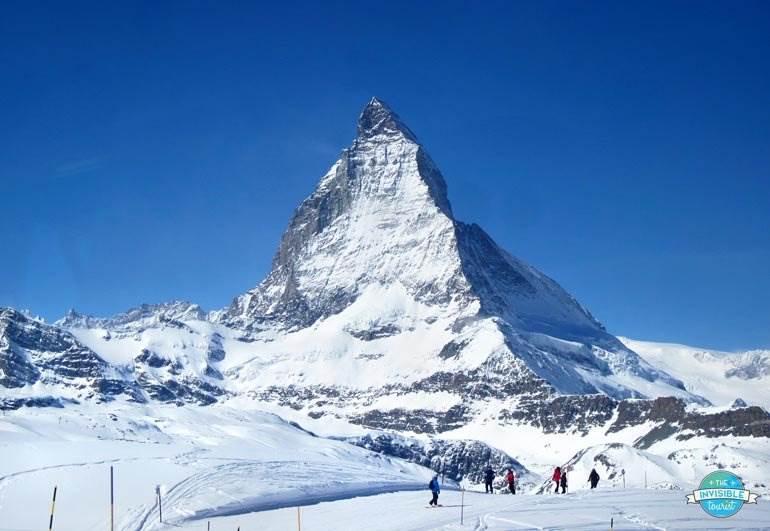
Travel independently or in small groups by avoiding large coach tours and cruises
What’s one of the worst things you could see in your city as a local? An endless sea of tourist groups piling out of coaches or cruise ships into narrow streets, following little flags, blocking roads and important throughfares with little regard for anyone else.
Being able to travel independently as much as possible is a major step to becoming a more responsible tourist. This is why I’ve created many flexible and easy-to-follow itineraries to help you! Sure, it may not always be the cheapest option but I’ll say ’til the cows come home: travelling in a sustainable way usually isn’t.
Large tours of 50 people in cities or whole countries are a major contributor to overtourism issues. When left uncapped, the numbers are completely unsustainable. It’s best to avoid these kinds of tours to not look like a tourist.
However, if you want to benefit from the insider knowledge of a guide at your destination consider small group tours (no more than 12-14 people) that immerse you in a particular area or neighbourhood. Local companies employing local guides can usually be found through a quick Google search, make sure to include “small group” in your query.
TIP: In Japan, I’ve enjoyed these small group experiences with local companies, and I can highly recommend them!

Rethink using vacation rental services in popular destinations
While I have written a dedicated article about Airbnb issues in detail, as mentioned earlier the nutshell version is time has proven that unregulated homestay accommodation has caused major issues for local communities across the globe.
One of the biggest issues has been tourists inadvertently taking long-term residential properties off the market for locals who need to live and work at the destination.
The responsible and ethical option is to avoid services such as Airbnb in popular destinations where there is already ample regulated accommodation, such as hotels, hostels and traditional B&Bs with a host present. Learn more in my guide to ethical Airbnb alternatives.
Take direct flights instead of multiple cheap ones
I’m aware flight comparison websites such as Kayak and Skyscanner are very popular with would-be travellers, however I have personally never been a fan or used them. If you know a little about me you’ll already be familiar with the idea that I always disliked these websites because they usually omitted direct flight options, instead only displaying cheap flights with multiple stopovers.
I want to reach my destination as quickly as possible rather than spend hours unnecessarily waiting around in airport terminals! Even if that comes at a higher price, I’m all for it to have the opportunity to spend more time exploring my destination.
From a responsible tourist standpoint, if you’re undertaking more flights that necessary it sure adds up from an environmental perspective. Take-off and landing use the most fuel. Here we go again – the cheapest option isn’t always the most sustainable.
TIP: If you want to take an extra step, you’re able to offset your carbon emissions for your flight.
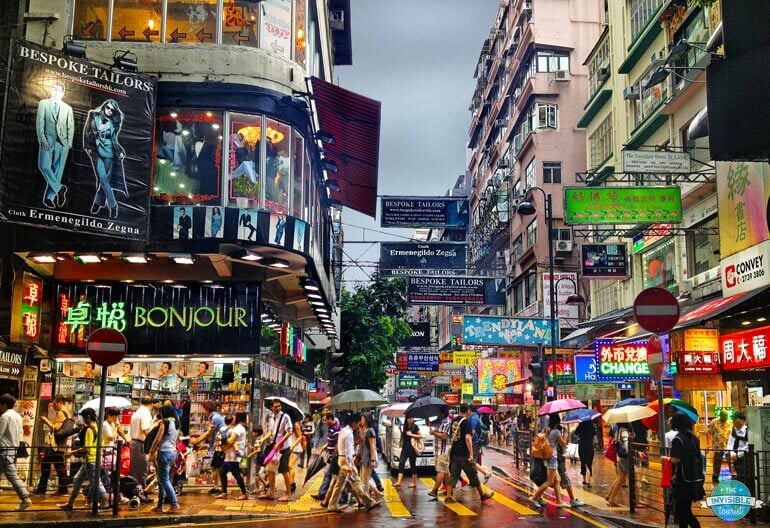
Avoid day trips to popular destinations
At destinations that are vulnerable to overtourism, day trippers compound the issues. Did you know 20 million people visit Venice, Italy each year? You can bet the more surprising fact is that only half actually spend the night! This means tourism money is locked into the large cruise companies with whom they arrived – not the local community.
On any given day, 120,000 day-tripping tourists descend on the medieval city and concentrate themselves around a small handful of famous sights. The 55,000 local residents who call Venice home are grossly outnumbered. Let’s get real: under the heavy burden of all those tourists, destinations such as Venice don’t need you there during their busiest times!
Relieve some of the pressure by slowing down, staying a few nights and dilute your tourist footprint by visiting the popular areas before day trippers arrive and once they have left. Enjoy several meals at local eateries away from the touristy sights. Your money will directly benefit locals this way, and they will thank you for it.
Another such place is Bruges, Belgium. Its charming canal-lined cobbled streets and medieval architecture make it a top choice for tourists on days trips from Amsterdam or even London. It’s so rewarding to extend your stay at least for a long weekend in Bruges to truly uncover a side of the city day trippers will miss!
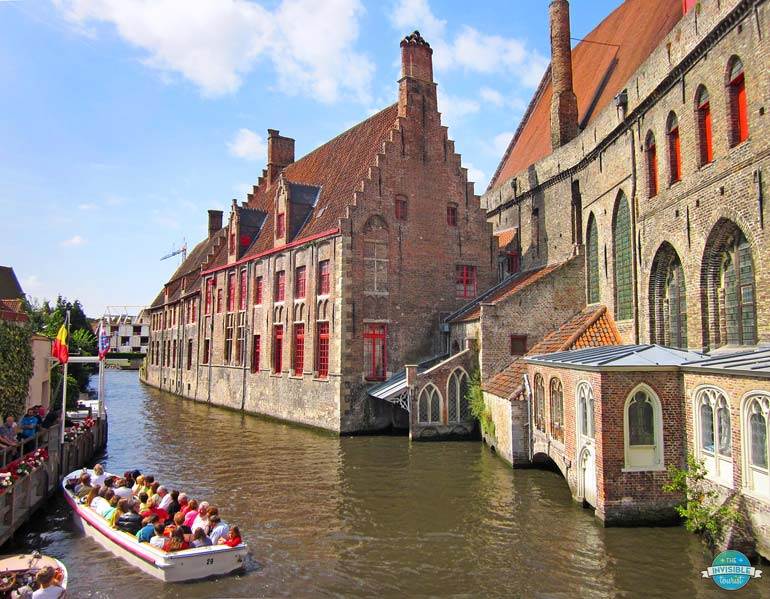
Seek out alternatives to popular spots
Remember the picturesque village of Shirakawa-go in the Japanese Alps I mentioned earlier? While it’s located over an hour from Takayama, many tourists don’t realise they can have a very similar experience just 15 minutes from Takayama’s town centre!
A gem in Takayama’s crown, the grassho-thatched roofs of farmhouses in Hida no Sato (Hida Folk Village) are a real treat for visitors who want to avoid crowds and learn more about life in this alpine region during the Edo Period (1603-1867).
Overtourism became a major issue in Kyoto, Japan’s ancient capital, with its preserved wooden townhouses, practicing geisha and ancient places of worship. If one researched beyond the major cities, they’d find there are real gems throughout the country that still maintain that old-world charm and intrigue that is so appealing to visitors – such as Kawagoe, Kurashiki and Kanazawa.
While I use Japan here as one such example, the same can be said for many destinations around the world. While some locations have been well-worn with tourist love, there are just as many hidden gems who would gladly appreciate new visitors!

Refrain from leaving love locks on bridges
For many years, leaving “love locks” on bridges throughout Europe seemed like the romantic thing to do. It’s a nice idea in theory to leave a piece representing you and your lover behind, right?
I’m proud to have gone against the grain and been one of the first travel bloggers to address the issues caused by love locks when I began my blog in early 2017. A lot has changed since then! Find out why you shouldn’t leave love locks in Paris or beyond here.

Post to social media in an ethical way (but don’t think about it until after you’re home)
Some time ago I remember reading an Instagram post from a fellow travel blogger saying she’d spend all day wandering around her destination trying to acquire a suitable photo to share. It saddened me to think this was the purpose of her day – there is SO much more to travelling than posting photos to social media!
Call me old-fashioned, but as someone who travelled well before smartphones and Facebook I tend not to even think about posting to social media until after I’ve returned home. Sure, I love to capture amazing shots as much as the next person however that should never be the sole purpose of travel.
Hastily-added photos online have caused a number of issues you may never have thought of. Here are some ways you can be a more mindful and ethical tourist when it comes to posting on social media:
Stop geotagging
Yes, I’m being serious. Instagram has been one of the driving forces behind the rise of tourism in recent years, with 57% of people in a survey admitting they were interested in travelling somewhere that would “look good” in social media pictures.
Geotagged locations made it all too easy for folks to flock to a location en masse without knowing the significance of the place aside from it being a pretty photo op. There’s no reward without work. Make people go to the effort to research for themselves!
Always ask for permission to photograph local people
When it comes to photography, always ask locals if they are comfortable having their photo taken before you snap away. While it may seem harmless to capture candid photos of local people, I know I personally don’t want an unauthorised photo of myself splashed across a random person’s social media page. Do you?
I can’t help but think back to the “Afghan Girl” story who appeared on the cover of National Geographic magazine. Also, it’s ethical to blur out faces in photos of locals you didn’t receive permission from (you may notice this in photos of crowds on my blog).
TIP: In Japan, it is against the law to photograph people without their consent. It stems back to an incident where a wife caught her husband with a mistress from a photo of him shared on social media. He took the case to court and won. Crop out identifying features and don’t land yourself in trouble!
Avoid risky situations with wild animals
Animal “selfies” are popular on social media. However, the extremes some people have gone to in order to achieve these shots have resulted in a hospital visit.
In Nara, Japan, over 200 injuries were recorded in 2018 from tourists teasing the sacred deer with food to lure them closer for selfies. Similarly in Yellowstone National Park in the United States, bison have charged at groups of people who have been too close, even flipping a 9 year old girl and goring a 62 year old man.
Wild animals are just that: wild and unpredictable. Please remember to admire these creatures from afar instead of risking injuries and encouraging others to achieve such photos.
Avoid placing yourself in avoidable situations
Cliff edges, boiling geysers, oncoming traffic and scaling structures illegally may gain you some social media attention, however placing yourself in these situations can sometimes cost you a prison sentence or even your life. If you have a young and impressionable audience, your actions may be justification for others to do the same.
TIP: Be aware of your surroundings, any hazards and abide by local signage to not be an irresponsible tourist.

Responsible tourist traits include knowing how to avoid pickpockets and scammers
How to be a responsible traveller? Know how to watch out for yourself to avoid your trip being ruined by a preventable issue. Sadly, there are people in this world who prey upon unsuspecting tourists for their valuables. The responsible thing is to be aware of these issues and to not fall victim to their sneaky tactics.
The unfortunate experiences of others inspired me to create this guide to how to not look like a tourist anywhere so you can fool pickpockets, know what types of scams to look for and proactively avoid them.
TIP: On the topic of valuables, don’t forget to take out travel insurance to cover unforeseen circumstances like lost luggage or health issues.
Child beggars
On a more sensitive note, if you’re visiting countries where child beggars are a common sight it’s important to resist the urge to give them money. Mind you, this doesn’t just happen in developing countries — it’s quite prominent in popular tourist destinations and shouldn’t come as a surprise when a young child approaches al fresco diners in Western Europe. I’ve experienced this first hand in Belgium, Italy, Netherlands and Spain to name a few.
While it may not be obvious at first, the parents of these children are never too far away and they use their children to pull on your heartstrings to surrender money. By giving them a few coins, it encourages this practice to continue and essentially keeps these children out of the education system. They deserve better.
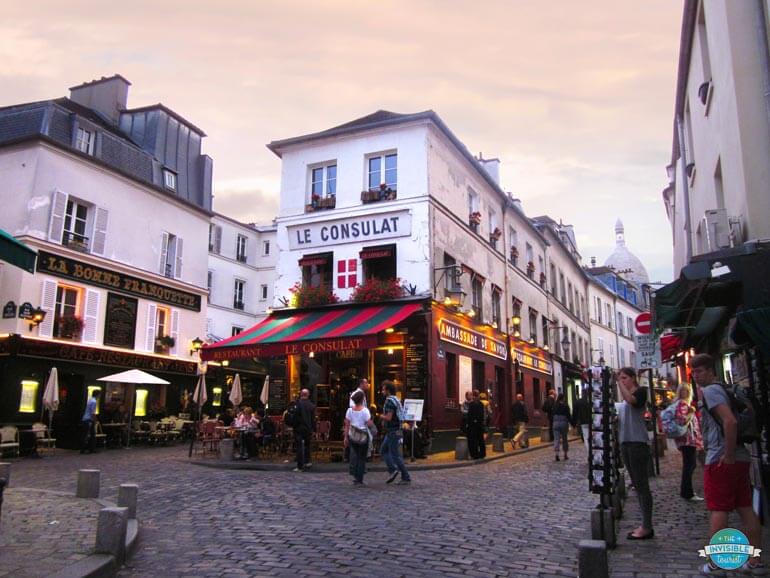
Ethical travel tips: Avoid animal exploitation in tourism
Remember earlier I mentioned I’ve seen a lot of change in travel attitudes during the past decade? Thankfully it hasn’t all been bad! As awful as it is for animals being exploited for tourism purposes, I’m pleased to have observed an increasing resistance against unethical animal encounters.
While just as short as a decade ago riding elephants and petting chained tigers in Thailand or visiting orcas in US theme parks was considered acceptable, tourists are now beginning to stand up for animals who live in terrible conditions and are forced to work for little reward.
As tourists, we pave the road towards change that leads to better conditions for animals used in tourism. There are a number of ways you can tell if animals are being exploited or not in this guide to ethical animal encounters.
NOTE: Concerns for animal welfare is the very reason why I’ve never recommended visiting exotic animal cafes in Japan, where it’s possible to cuddle a hedgehog and share lunch with an owl — yes, really.
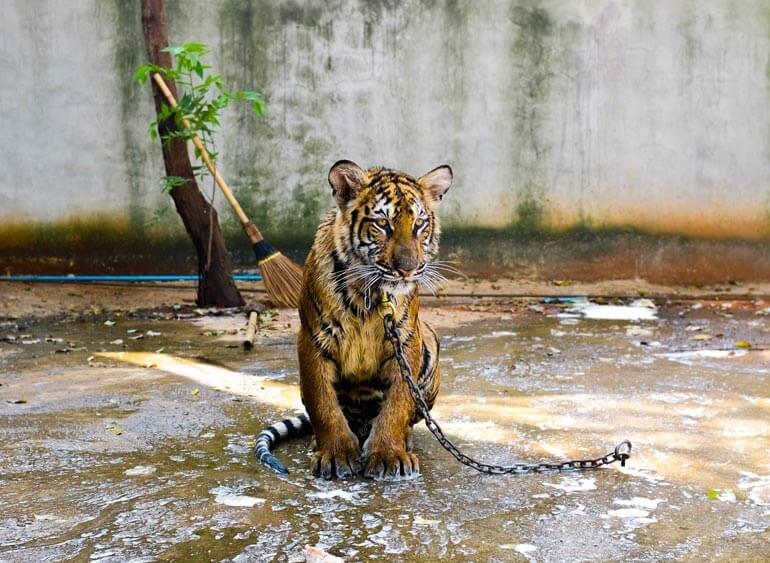
Learn some basics of the local language
I really can’t express enough how helpful it is to learn a few basic phrases of the local language. It can mean the difference between a hostile reception for locals or a warm, welcoming one!
In my guide to learning language for travel, I detail how I’ve managed to teach myself a handful of language basics using six essential resources – and quickly, too!
TIP: If you’re planning a trip to Japan someday, my detailed guide to Japanese for tourists can help you master the essential words and phrases in no time.
Leave No Trace
Love hiking and immersing yourself in the outdoors? Chances are you may have already heard of the Leave No Trace principles. These are a set of guidelines for responsible tourists to follow to ensure nature is left exactly as you found it for the benefit of local flora, fauna and future generations.
These guidelines remain the copyright of Leave No Trace Center for Outdoor Ethics so I highly recommend you check them out directly for further information on each principle below.
The Leave No Trace Seven Principles
- Plan Ahead and Prepare
- Travel and Camp on Durable Surfaces
- Dispose of Waste Properly
- Leave What You Find
- Minimize Campfire Impacts
- Respect Wildlife
- Be Considerate of Other Visitors
© 1999 by the Leave No Trace Center for Outdoor Ethics: www.LNT.org

Why is responsible tourism important?
With an ever-increasing number of irresponsible tourists flooding destinations and causing issues (whether they are aware of them or not), it’s never been more important to raise awareness to past mistakes and implement changes moving forward.
Travelling in a responsible, sustainable way helps ensure we leave a positive impact that benefits local communities and helps preserve our delicate environment. It forges connections with locals, helps promote understanding across different cultures and sends your tourist money to people who need it most.
I’ll admit in my earliest days of travelling I made mistakes without realising at the time. Yes, I’ve ridden on a fatigued donkey’s back in Santorini, taken part in a large coach tour of 50 people and visited Venice during the summer peak. Even then, each didn’t feel quite right and knowing what I know now, I would have chosen differently.
While I regret those early decisions, the important thing is I quickly realised the harm my decisions caused and learnt from them. Responsible tourists always strive to improve.
The ability to travel this amazing world we live in is an incredible opportunity and life-changing experience. In order for travel to be as enjoyable as possible, as tourists we need to make responsible choices to ensure it is done in a sustainable way to benefit us now and generations into the future. And of course for the locals call these destinations their home, too!
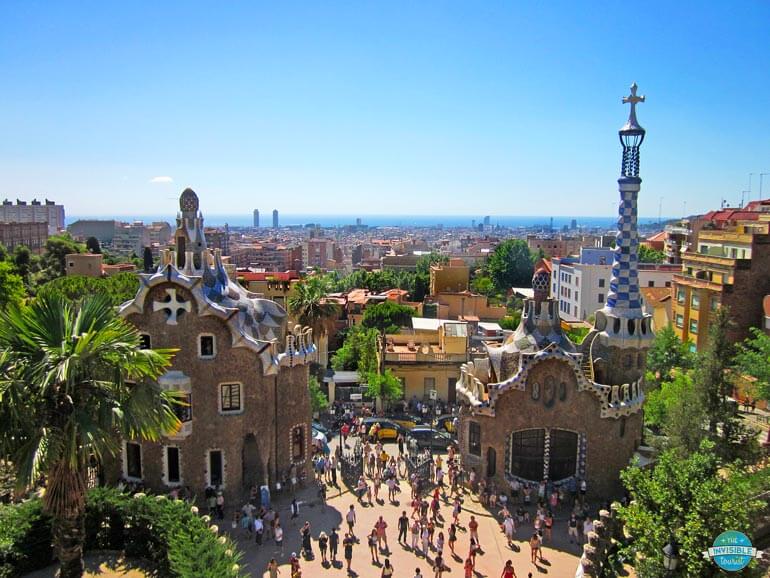
BONUS: Allow your passions and interests to guide you
Considering I always see people in online travel forums express their desire to visit a destination without knowing why they want to to go, this is an important point to keep in mind!
For instance, if you ask Japan enthusiasts what the must-sees are in each Tokyo neighbourhood, undoubtedly the Tsukiji Fish Market and tuna auction will be a solid answer. Despite visiting Japan’s capital over a dozen times in the past decade, I’ve still not made the trip as it doesn’t interest me as much as other places. Yes, that’s an unpopular truth.
I’d advise not visiting a place just for the sake of it if it doesn’t interest you, it won’t be a good use of your precious travel time. Allow your passions and interests to guide you in crafting your perfect itinerary so every part of the trip is your favourite part.
Whether it be art galleries, museums, foodie experiences or anything else, the very first step when thinking about visiting a destination is to remember to do what YOU love!
If you’ve read the first three paragraphs on my homepage, you’ll already be familiar with the notion that every article on this blog has been designed to help you be a more mindful, responsible and therefore invisible tourist. My passion for this grew so much so, I’ve literally written the book on how we can use our hidden power as tourists to improve tourism in the future. Take a look!
Concluding these tips for how to become a responsible tourist
This concludes my monster guide to my responsible tourism tips! Now you’re armed with the knowledge for how to be a better tourist when through each decision you make during the trip planning process.
May we all be mindful of local customs, etiquette and know the benefits of learning some language basics. May we understand the importance of giving back to local communities and doing what we can to minimise our tourist footprints. We know responsible tourist traits include not supporting animal exploitation and posting ethically to social media — just to name a few.
I hope these actionable responsible tourism tips inspire more of us “blend in” and be responsible travellers during our bucket list trips, wherever they may be.
Do you have any tips for ethical tourism?I’d love to hear them! Let me know in the comments below, over on Facebook, YouTube, Instagram, TikTok or come and join me on Pinterest for more ways to “be invisible” around the globe!
Until next time,

Like it? Pin it for later! 📌

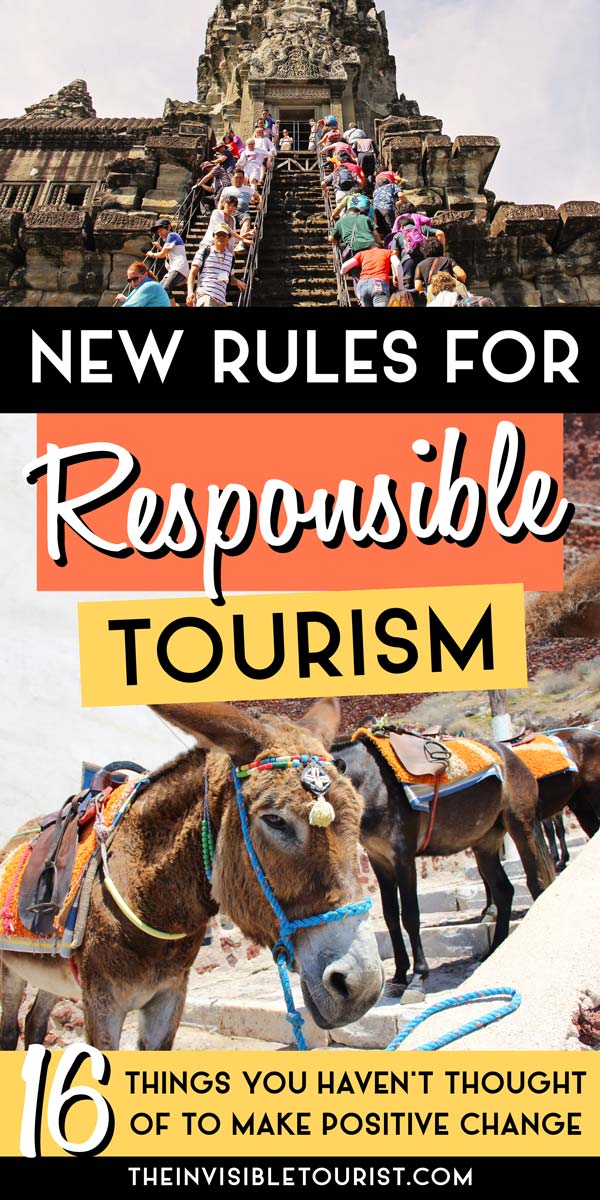

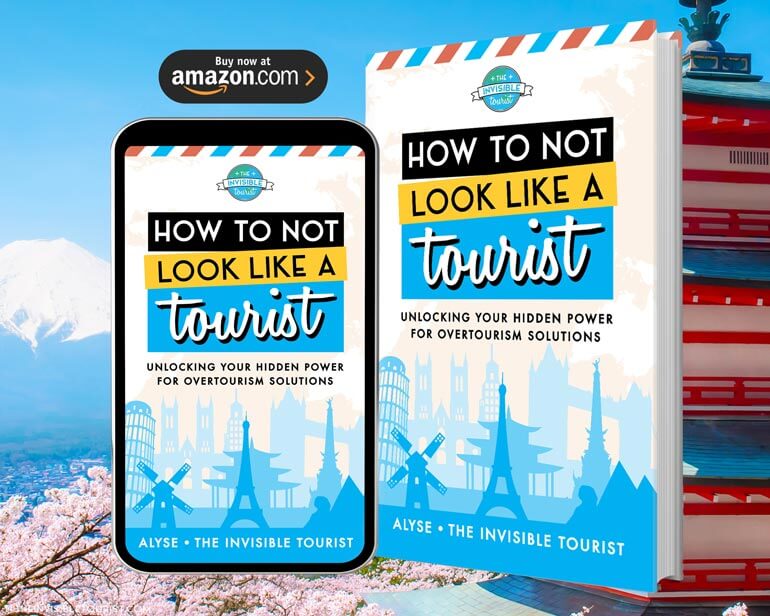
Responsible Traveller was an interesting article.
Disposable chopsticks used in Japan are made from waste wood or trees felled to maintain forests.
The idea of using something that can be used repeatedly is an excellent one!
However, disposable chopsticks in Japan are themselves eco-friendly, so there is no problem using them.
From the Japanese, for your information.
Hi Taro san, thanks for your kind words and for your insight!
That is great news, thank you for sharing 😊
I’m finding all of your posts to be super helpful. Thank you!
I’m so glad to hear that, thank you Jordan! 😃
As someone that grew up in a popular tourist area (southern Florida), my biggest dislike of tourists boils down to a lack of respect for the locals and employees.
I got the chance to study abroad in Scotland for a bit and lived in Glasgow. I loved Glasgow as it felt “real”. Same with Dublin and Amsterdam (no, I didn’t go there for that!) I hated London because I fell into the “tourist” trap for a bit.
The overtourism is real. I’m glad that someone put a name to the feeling.
Thanks for sharing your perspective, Matt! 😃
I’m yet to visit Glasgow, but loved my time in other Scottish cities.
Totally understand what you mean about Amsterdam, Dublin and London. All are great cities beneath the tourist traps 🙂